You can safely eliminate fleas using natural methods that protect your pets from harsh chemicals. Start by vacuuming every other day and washing pet bedding in hot water weekly. Apply food-grade diatomaceous earth to carpets, give your pets Dawn dish soap baths, and use essential oil sprays with lavender or peppermint. Control humidity below 50%, comb pets regularly with flea combs, and treat your yard with beneficial nematodes. These thorough strategies will help you discover additional effective solutions.
Regular Vacuuming and Hot Water Washing
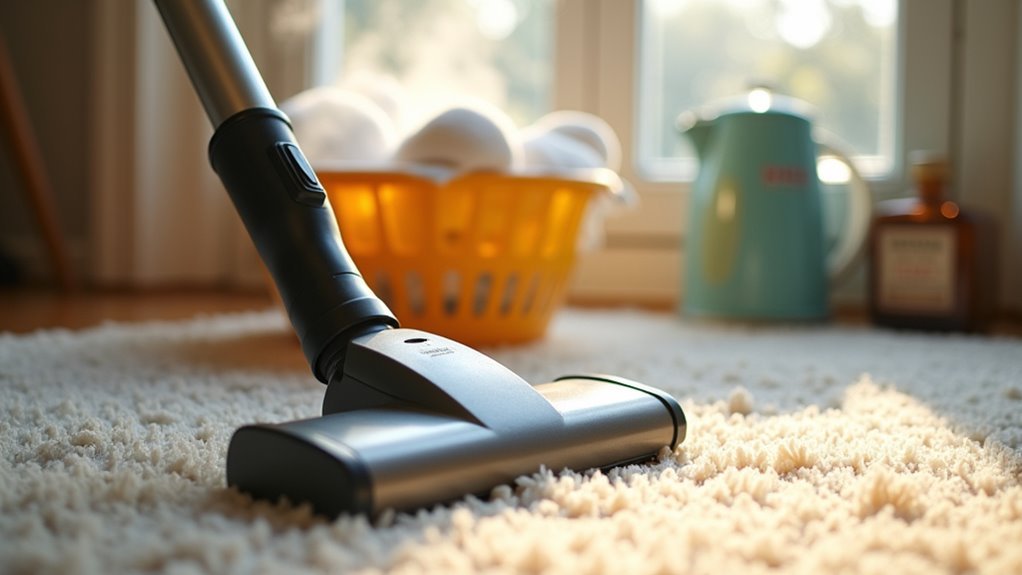
When dealing with a flea infestation, your vacuum cleaner becomes one of your most powerful weapons. Regular use of vacuuming every other day effectively removes adult fleas, eggs, and larvae from carpets and furniture.
Your vacuum cleaner is your most effective weapon against fleas when used consistently every other day.
Focus on areas where your pets spend most of their time, including under furniture and around their favorite spots to reduce flea populations considerably.
Complement your vacuuming efforts with hot water washing of your pet’s bedding weekly. This combination disrupts the flea life cycle by eliminating fleas at multiple stages of development.
After vacuuming, immediately empty the bag or canister outside to prevent re-entry. For enhanced results, use a steam cleaner on carpets and upholstery, as the heat will eliminate fleas and their eggs completely.
Diatomaceous Earth Application
When using diatomaceous earth for flea control, you’ll need to select only food-grade DE to guarantee your pet’s safety.
Apply it by sprinkling a thin layer in areas where fleas congregate, such as carpets, pet bedding, and floor cracks, then leave it undisturbed for at least 48 hours.
You must wear a mask during application and keep pets away from treated areas until the dust settles to prevent respiratory irritation.
Food Grade DE Only
Food grade diatomaceous earth offers pet owners a natural, non-toxic solution for flea control that’s both effective and safe around your furry companions.
When selecting DE for flea control, you must choose only food grade quality. This designation guarantees the product hasn’t been chemically treated and remains safe for pet-friendly use around your home.
Pool grade or industrial DE contains harmful chemicals that can seriously injure pets and humans.
Food grade diatomaceous earth will effectively kill fleas by damaging their exoskeletons, causing them to dehydrate and die.
Apply it sparingly to pet bedding, carpets, and areas where fleas congregate. The fossilized diatoms work mechanically rather than chemically, making this method completely natural while maintaining its pest-controlling effectiveness.
Proper Application Techniques
Several key steps guarantee you’ll apply diatomaceous earth effectively while keeping your pets safe throughout the process.
These proper application techniques make certain maximum flea control while maintaining a pet-friendly environment.
Follow these essential steps for effective diatomaceous earth application:
- Wear protective gear – Use a mask and gloves to prevent inhalation and skin irritation from fine particles.
- Maintain dry conditions – Apply only to completely dry areas, as moisture reduces DE’s ability to kill fleas.
- Apply thin layers – Sprinkle lightly across carpets, pet bedding, and corners where pets frequent.
- Wait before cleaning – Allow diatomaceous earth to remain for at least 48 hours before vacuuming.
After treatment, vacuum thoroughly and immediately dispose of vacuum contents to prevent reinfestation in your home.
Safety Precautions Required
While diatomaceous earth offers an effective natural solution for flea control, you must take specific safety precautions to protect both yourself and your pets during application.
Always wear a mask and gloves when you apply diatomaceous earth to prevent respiratory issues and skin irritation. Only use food-grade diatomaceous earth, as other types contain harmful additives that aren’t pet-friendly.
Keep your pets away from treated pet-frequented surfaces until the dust settles completely and you’ve vacuumed excess powder. This prevents potential irritation or accidental ingestion.
Allow the diatomaceous earth to work for at least 48 hours before cleaning to guarantee maximum effectiveness against fleas and larvae while maintaining a safe environment for your family.
Beneficial Nematodes for Yard Treatment
Since chemical pesticides can pose risks to your pets and family, beneficial nematodes offer a natural solution that targets flea larvae directly in your yard.
These microscopic worms provide effective biological control while remaining completely harmless to pets, humans, and plants, making them the perfect eco-friendly alternative for outdoor areas.
To maximize your nematode treatment’s success and achieve long-term flea control:
- Apply during evening hours or cloudy days to protect nematodes from direct sunlight
- Make sure soil remains consistently moist for ideal nematode survival
- Focus application on areas where your pets spend the most time
- Reapply as needed to maintain effective populations
Studies confirm that beneficial nematodes greatly reduce flea populations in treated areas, offering sustainable pest management without compromising your family’s safety.
Dawn Dish Soap Baths
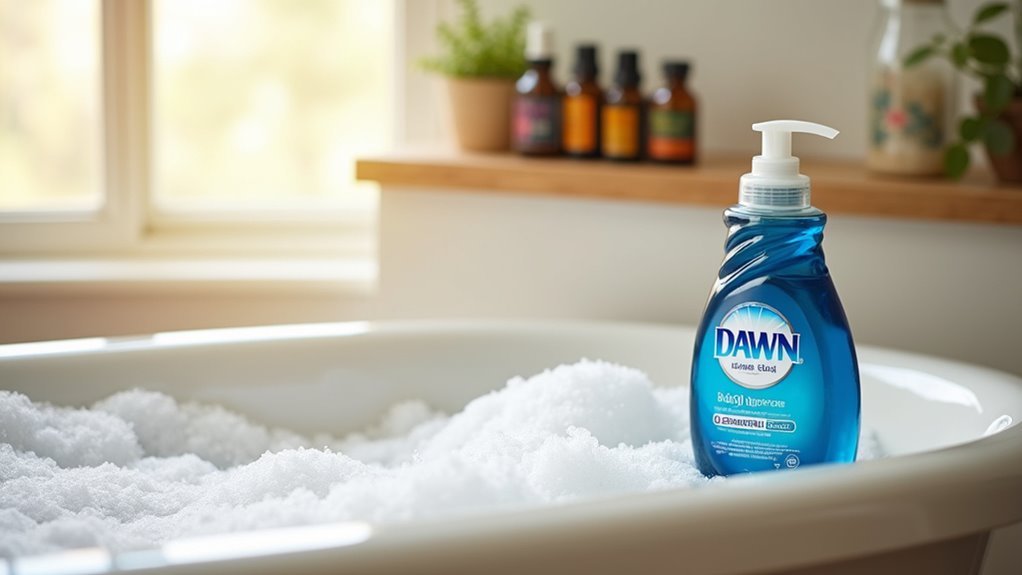
Dawn dish soap transforms into a powerful weapon against fleas when you need immediate relief for your pet. This pet-safe method works by breaking down the flea’s exoskeleton, causing dehydration and death upon contact.
When killing fleas with Dawn, lather the soap thoroughly into your pet’s fur and skin, ensuring thorough coverage reaches all areas. Let it sit for 5-10 minutes before rinsing completely. Keep soap away from your pet’s eyes, ears, and mouth during treatment.
While regular bathing helps reduce flea populations on your pet, don’t rely solely on this approach. Dawn provides excellent immediate relief, but you’ll need additional long-term flea prevention strategies for extensive control.
Essential Oil Flea Sprays
Although essential oils require careful application, they offer a natural approach to repelling fleas from your pet’s environment.
These pet-friendly alternatives can effectively complement your flea control strategy when used properly.
When applied correctly, these natural alternatives provide an effective addition to your comprehensive flea prevention plan.
Here’s how to safely use essential oil sprays:
- Choose safe oils – Lavender, lemongrass oil, and peppermint work well to repel fleas.
- Dilute properly – Always mix with carrier oils to prevent skin irritation.
- Create DIY insect repellent – Combine 1 cup water with 10 drops each of lemongrass and lemon eucalyptus oils.
- Reapply frequently – Spray every 1-2 hours during outdoor activities for maximum effectiveness.
Remember to consult a veterinarian before using essential oils, especially with cats, as some oils can be toxic to felines.
Cedar Chips and Natural Repellent Bedding
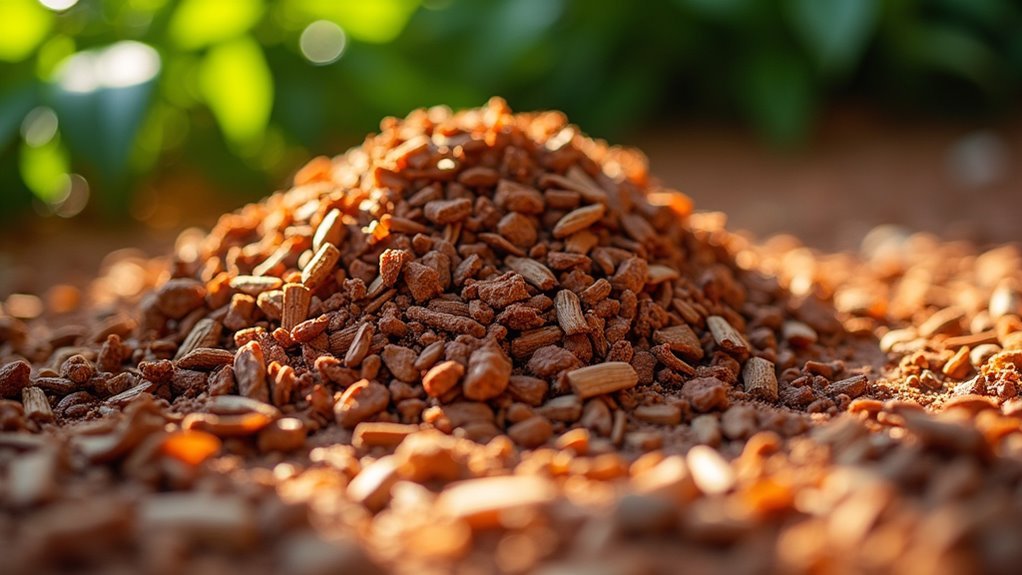
You’ll find cedar chips offer a powerful natural solution for flea control through their inherent oils that repel these unwanted pests.
Cedar’s scent creates an environment fleas actively avoid, making it an excellent choice for your pet’s bedding areas.
When you apply cedar chips properly in bedding, you’re providing both comfort for your pet and effective flea prevention without harsh chemicals.
Cedar’s Natural Repelling Properties
When you’re searching for a natural flea deterrent that’s safe for your furry companions, cedar chips offer an effective solution backed by nature’s own pest-fighting compounds.
Cedar’s natural oils actively repel fleas while providing excellent pest control without harsh chemical treatments.
Cedar’s repelling properties work through several mechanisms:
- Aromatic oils create an inhospitable environment that fleas naturally avoid
- Pleasant scent keeps your pet’s sleeping areas fresh and inviting
- Long-lasting protection when chips are regularly replaced to maintain potency
- Safe alternative to toxic substances for households prioritizing natural approaches
You can incorporate cedar chips into pet bedding areas where your animals rest most frequently.
This strategic placement helps prevent flea infestations before they start, making cedar one of the most practical natural alternatives available.
Safe Bedding Application Tips
While cedar chips provide excellent natural protection, proper application guarantees maximum effectiveness and your pet’s comfort.
Follow these safe bedding application tips by placing cedar chips directly in your pet’s sleeping area or mixing them with existing bedding materials. The natural oils in cedar chips work continuously to repel fleas, creating an invisible barrier around your pet’s resting space.
Replace cedar chips every two to three weeks to maintain their potency. You can also incorporate essential oils like lavender or eucalyptus into bedding for added protection.
Always monitor pets closely for skin irritation, excessive scratching, or respiratory issues. If you notice adverse reactions, remove the bedding immediately and consult your veterinarian for alternative flea control methods.
Flea Combing and Physical Removal
A flea comb serves as your first line of defense against these persistent parasites, offering a chemical-free way to remove fleas, eggs, and waste directly from your pet’s coat.
This pet-friendly physical removal method helps you detect early infestations before they become extensive problems.
Focus your flea combing efforts on these key areas:
- Neck and collar region – where fleas often hide
- Base of the tail – a prime flea congregation spot
- Underbelly areas – warm spots fleas prefer
- Behind ears – another common hiding place
Keep soapy water nearby to drown captured fleas immediately.
Regular bathing with mild soap enhances combing effectiveness.
Boric Acid Carpet Treatment
Physical removal tackles fleas on your pet, but you’ll need to address the larger population living in your carpets and rugs.
Boric acid carpet treatment offers a nontoxic option that can dehydrate and kill fleas effectively. Use only food-grade boric acid, which is safer for pets and children than industrial variants.
Sprinkle a thin layer over your carpets, allowing it to settle into fibers and disrupt the flea life cycle. Leave the treatment in place for 24 to 48 hours before vacuuming to guarantee maximum effectiveness against fleas and their eggs.
Maintain proper ventilation during application and keep pets away from treated areas until you’ve completed vacuuming and dust has settled to minimize exposure.
Herbal Flea Collars and Sachets
You can craft effective herbal flea collars using simple materials and natural essential oils that repel fleas without harsh chemicals.
Creating your own collar allows you to control the ingredients and customize the scent strength for your pet’s comfort.
However, you’ll need to understand essential oil safety guidelines since some oils can irritate sensitive skin or prove toxic to certain animals.
DIY Herbal Collar Creation
When commercial flea collars contain harsh chemicals that might irritate your pet’s sensitive skin, creating your own herbal collar offers a gentle yet effective alternative.
These pet-friendly alternatives use natural essential oils to repel fleas effectively while keeping your furry friend comfortable.
Creating a DIY herbal collar involves these simple steps:
- Select a cotton or fabric collar base
- Mix 1-2 drops of lavender, cedarwood, or peppermint essential oils with carrier oil
- Apply the blend evenly and let it absorb completely
- Place the collar on your pet after ensuring proper fit
Always monitor your pet for irritation or allergic reactions, adjusting oil concentration as needed.
Consider making herbal sachets with dried rosemary or mint for bedding areas, revitalizing both collars and sachets every few weeks.
Essential Oil Safety
While these homemade remedies offer natural flea protection, proper safety measures protect your pet from potential harm.
Essential oils must be diluted correctly before use, as concentrated formulations can cause skin irritation or allergic reactions in sensitive pets. This natural alternative requires careful preparation and monitoring.
Some essential oils are toxic to certain animals, particularly cats, who can’t metabolize specific compounds effectively.
You should always consult with a veterinarian before introducing any herbal remedies to your pet’s routine. They’ll advise which oils are safe for your specific animal and recommend proper dilution ratios.
Monitor your pet closely after applying herbal collars, watching for redness, excessive scratching, or behavioral changes that indicate discomfort.
Environmental Humidity Control
Since fleas depend heavily on moisture to complete their life cycle, controlling your home’s humidity levels becomes one of your most effective weapons against these persistent pests.
Fleas thrive when indoor humidity reaches 70-85%, but you can disrupt their development by maintaining levels below 50%.
Keep indoor humidity below 50% to disrupt flea development and prevent these moisture-dependent pests from completing their life cycle.
Here’s how to create an environment where flea eggs and larvae can’t survive:
- Install dehumidifiers in basements, bathrooms, and other damp areas
- Run air conditioning and guarantee proper ventilation throughout your home
- Increase regular cleaning frequency to remove moisture-retaining dust and debris
- Maintain consistent vacuuming schedules to eliminate eggs while reducing ambient moisture
This natural approach targets fleas at their most vulnerable stage without exposing your pets to harsh chemicals.
Frequently Asked Questions
What Kills Fleas Without Harming Pets?
You’ll find diatomaceous earth effectively kills fleas through dehydration without harming pets. Use beneficial nematodes for larvae, vacuum regularly, wash bedding in hot water, and apply diluted essential oil sprays for thorough protection.
What Do Holistic Vets Recommend for Flea and Tick Prevention?
Holistic vets recommend regular grooming with natural shampoos, diluted essential oils like lavender, beneficial nematodes for yards, frequent vacuuming, washing bedding in hot water, and omega-rich diets for healthier skin.
What Is the Best Pet Friendly Way to Get Rid of Fleas?
You’ll get best results combining regular vacuuming with washing pet bedding in hot water, bathing your pet with natural shampoos, and applying diatomaceous earth to carpets and outdoor areas.
What Is a Natural Alternative to Flea Treatment for Dogs?
You can use diatomaceous earth sprinkled on bedding and carpets to dehydrate fleas. Apple cider vinegar works as a repellent when sprayed or added to water, naturally balancing your dog’s skin pH.
In Summary
You’ve now got ten effective, pet-safe methods to tackle flea infestations without risking your furry friend’s health. Remember, consistency is key—you’ll need to combine multiple approaches and stick with them for several weeks to break the flea lifecycle completely. Don’t get discouraged if you don’t see immediate results; these natural methods take time but they’re worth it for your pet’s safety and your peace of mind.

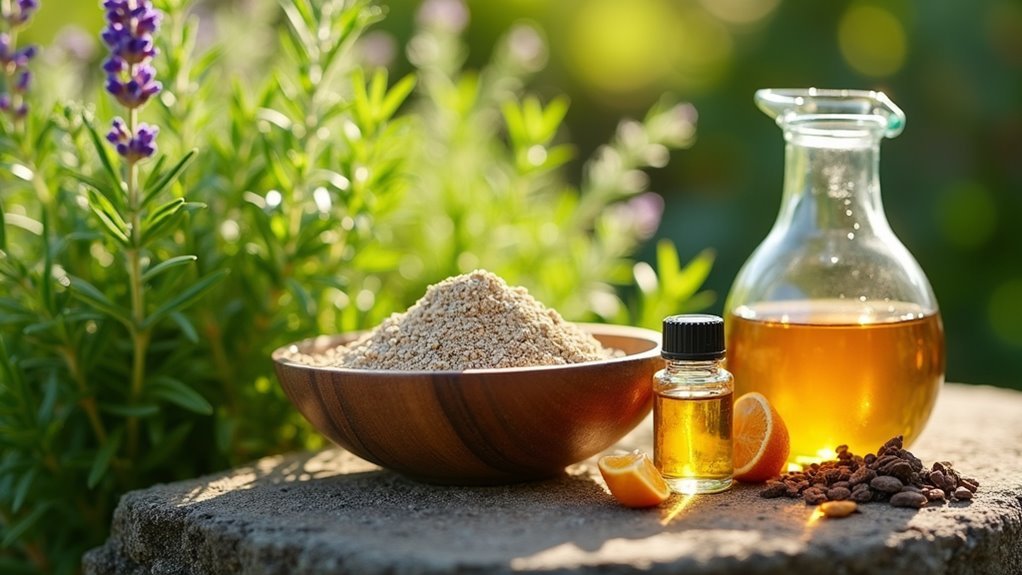
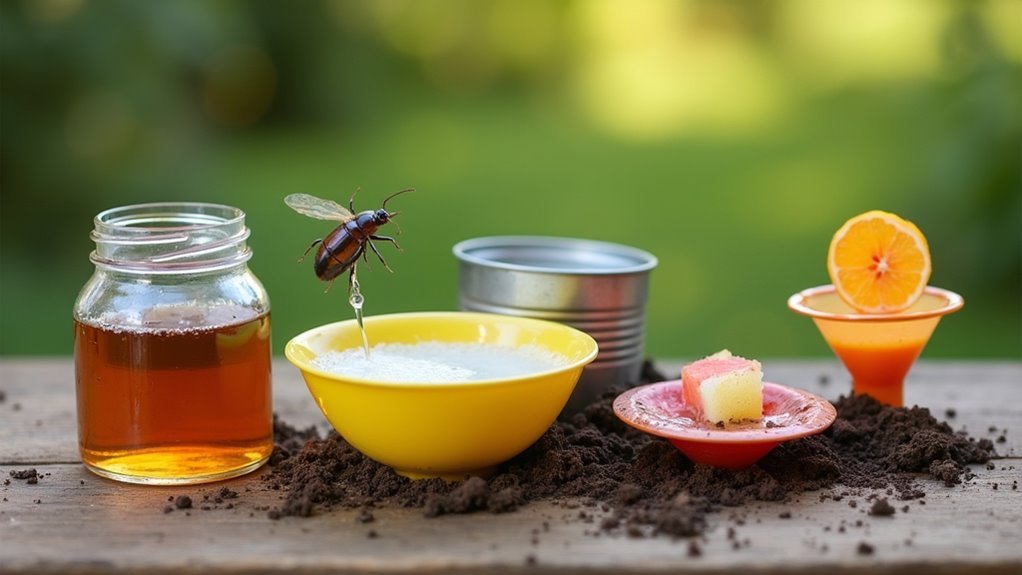
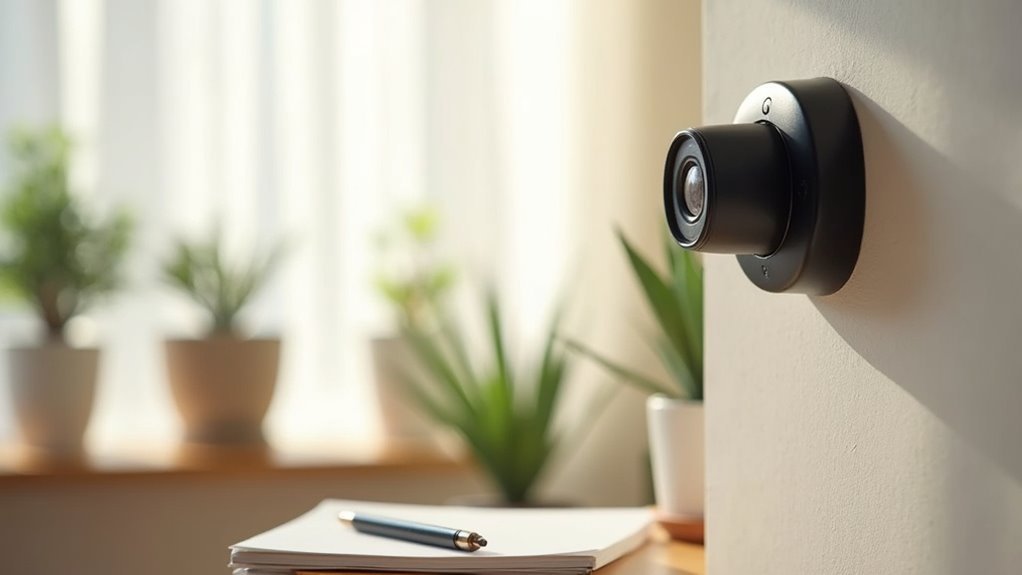
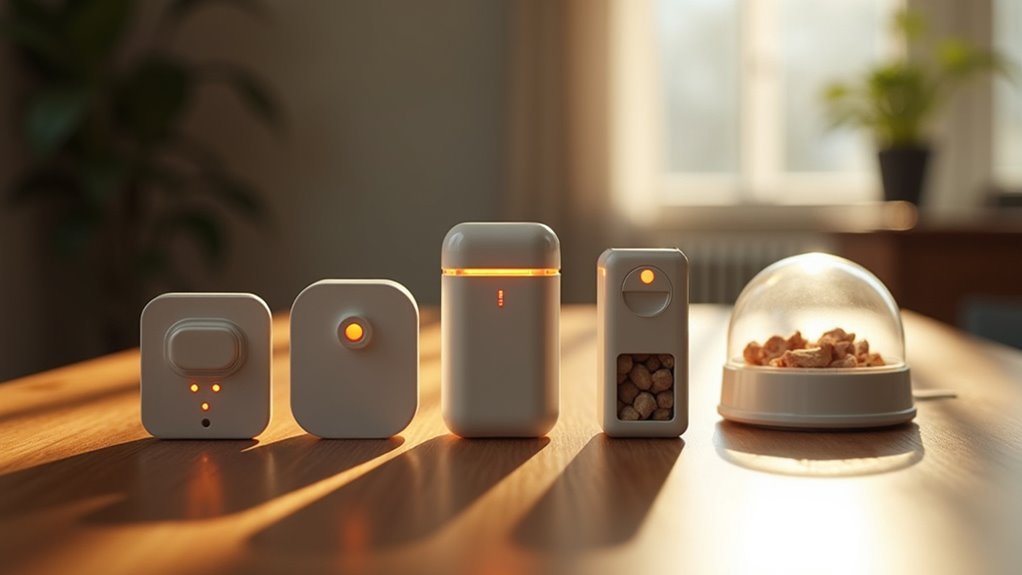
Leave a Reply